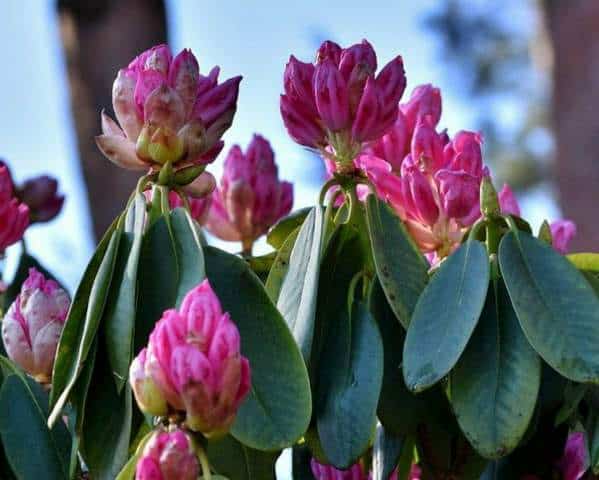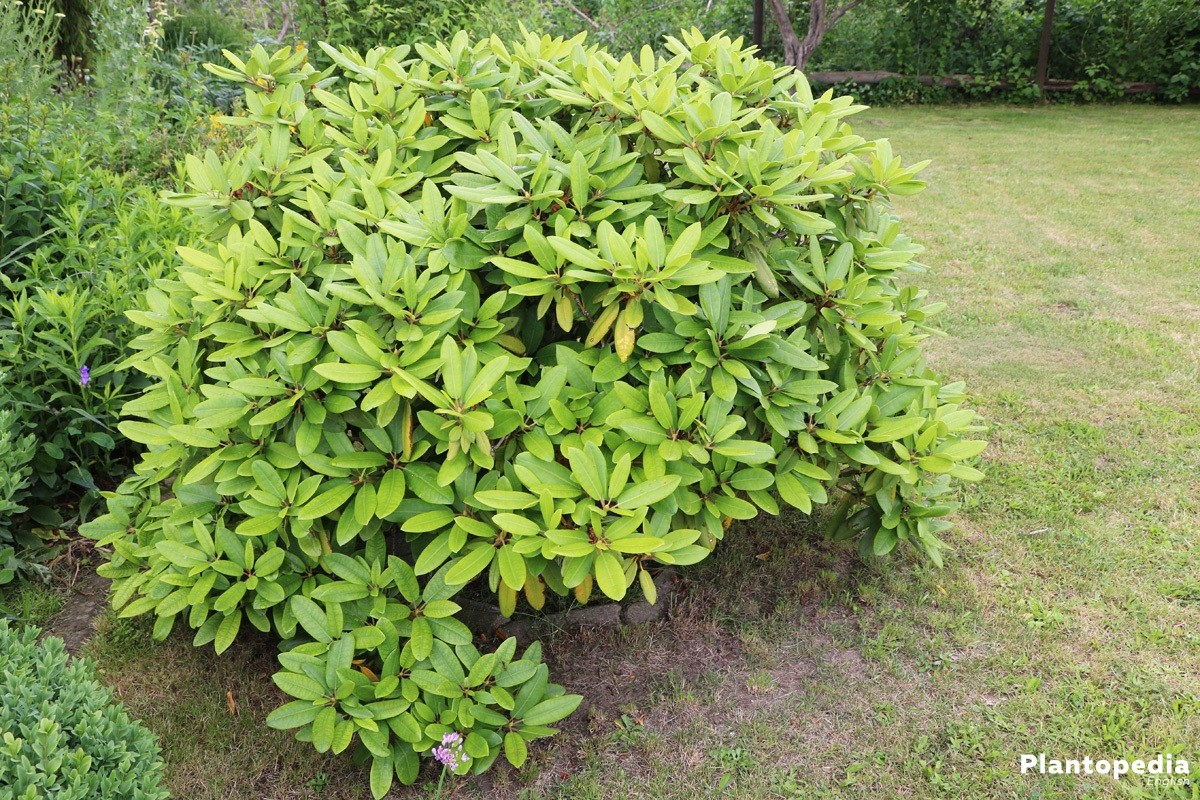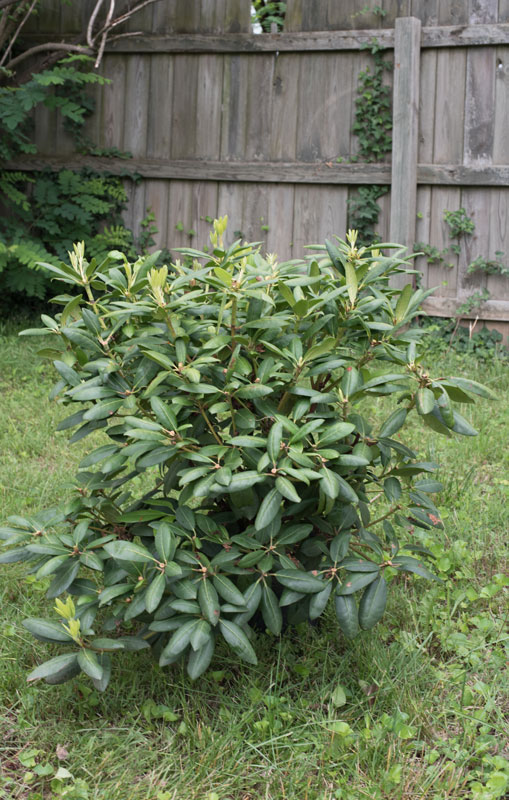
Popular spring-blooming flowering shrubs are rhododendrons. For flowering, they prefer a protected area with dappled sunlight and acidic soils.
When developing flower buds are eliminated by pruning at the incorrect time of year or when emerging flower buds are damaged by a late frost, rhododendrons will not bloom. Rhododendrons can also be prevented from blossoming by dry conditions, alkaline soils, a lack of sunlight, and nitrogen fertilizer.
Continue reading to find out the reason why your rhododendron isn’t blooming and how to fix it.
Table of Contents
1. Pruning at the Wrong Time of Year (Removes Flower Buds)
Around August, rhododendrons, azaleas, camellias, and clematis begin to form their flower buds. These buds remain dormant over the winter before blooming the next spring or summer.
If you firmly prune your rhododendron in the fall, you’ll probably remove all the flower buds, which will prevent the rhododendron from blooming the following year.
Rhododendrons won’t likely flower for two years after being trimmed back (at the wrong time).
Roses require annual pruning, whereas rhododendrons don’t, and they flower on old wood rather than the growth of a new season.
However, to maintain the plant appearing healthy, it may be required to prune back and shape rhododendrons as well as remove old, ineffective wood.
Rhododendrons should be pruned back immediately after flowering to avoid cutting off the developing flower buds for the following year and forcing a year without blossoming.
Rhododendrons can grow back and form buds for the following year’s flowers if they are pruned soon after blossoming.
Here is a YouTube video on how to prune rhododendrons that includes all the best practices:
2. Not Enough Sunlight for Flowering
Finding the ideal ratio of light and shade is crucial for rhododendrons to bloom.
Rhododendrons cannot produce flower buds or show off flowers if they are completely shaded out, without even the slightest amount of brilliant indirect light.
In their natural habitat, rhododendrons grow and bloom beneath a forest canopy that offers dappled light all day long.
The rhododendron, however, might experience leaf burn and water stress if it is in direct sunlight.
By placing rhododendrons in an area of your garden with dappled sunshine or partial shade, you can try to mimic the rhododendron’s natural habitat.
Cut back some overhanging tree limbs to allow more light to reach your rhododendron so it can produce flower buds and bloom the next year, or transplant it (if possible) in the spring or fall to an area with more light.
Rhododendrons can withstand morning sun (to encourage flowering), followed by shade throughout the hottest parts of the day—midday and afternoon.
3. Too Much Fertilizer, Fewer Flowers

Since rhododendrons don’t require as much food as other flowering shrubs, like roses, they frequently don’t require an annual fertilizer application if the soil is nutrient-rich or has been treated with organic matter (like compost) before planting.
Rhododendrons, however, can benefit from supplemental fertilizer to provide them with the necessary nutrients for good growth and the resources to flower if they are planted in containers or poor, sandy soil.
I always use a specialized fertilizer from miracle-gro for rhododendrons, azaleas, and camellias since it has the proper ratio of nutrients at the proper concentration to sustain blooming.
To ensure the rhododendron can flower, you may easily prevent providing too much nitrogen by using a precise fertilizer and remove the element of guesswork.
Leave the rhododendron to recover for a year without applying any fertilizer, and if the plant is healthy, it should flower the following year and develop flower buds if you have a lot of foliage but no flowers and you’ve used a lot of fertilizer.
4. Frost Damage Flower Buds
Frost damage is a common issue with plants like rhododendrons, which create the flower buds for the following year after this year’s flowering (often starting in August).
The flower buds typically turn brown during a late spring frost as the blooms start to emerge, which of course stops blossoming.
Rhododendron flower buds are still susceptible to frost, but the leaves may frequently withstand it.
While it is best practice to remove badly frost damaged flower buds, this won’t encourage new flowers because rhododendrons do not repeat flower, and there isn’t much you can do to salvage flower buds once they have been injured by frost.
However, it is a good idea to plant (or transplant) your rhododendron in a relatively protected spot of the garden, such as under a tree in a corner with some protection, if your area regularly experiences cold temperatures in the winter.
The flower buds of rhododendrons that are outdoors in open spaces are more susceptible to harm from frost.
You can also lessen some damage by covering flower buds with horticultural fleece before a late frost, but I believe it is more practical to choose a protected location to grow your rhododendron.
5. Drought Stress Prevents Flowering
To develop and flower, rhododendrons need wet, well-draining soil. The plant will become stressed and the spring flower buds won’t open if the soil is too dry.
For a variety of causes, the soil around rhododendrons may be dry:
- Rhododendrons thrive in the filtered light provided by a tree canopy, but if the canopy is too thick, it may effectively intercept and deflect rainwater away from your plants, leaving them with dry soil.
- Rhododendrons and tree roots may compete for moisture in the soil, which decreases the amount of water that is accessible to your rhododendrons.
- Additionally, excessive sunlight can worsen soil evaporation and leaf water loss.
- Rhododendrons need constantly wet soil, therefore soil that dries out easily or that drains quickly won’t allow them to bloom.
Your rhododendron might not flower this year if it has experienced severe drought stress, but you can simply fix this so that it blooms nicely the next year.
The answer is to mulch the area around the rhododendron in order to improve soil structure, add nutrients to the soil, and aid in water conservation.
Compost, leaf mold, or well-rotted manure should be smeared on top of the soil surface surrounding the rhododendron to a depth of one inch.
The amazing ability of organic materials to hold water, such as compost, leaf mold, or manure, keeps the roots cold and the rhododendron hydrated so that it can flower.
So that the plant may flower, make sure the soil is continuously moist throughout the growing season by probing the earth with your finger to look for moisture.
Give the rhododendron a good bath if the soil is starting to dry up to keep it moist and to help the roots take root in the ground.
The rhododendron should have the resources to produce flowers with careful monitoring, watering as needed, and mulching in the spring.
6. Alkaline Soil Prevents Rhododendrons From Flowering

Rhododendrons do best on soil that has an acidic pH of 4.5 to 6.0.
Although they may survive in slightly less acidic soils (7 is pH neutral), they usually grow poorly and produce fewer flowers.
As they are likely to be familiar with the local soil conditions, talking to a neighbor who is an avid gardener or horticulturist in the region is the quickest and frequently best approach to determine your soil’s pH.
Alternately, you can get a soil gauge from Amazon or a garden center to test your soil’s pH to check if it is within the range that rhododendrons need to thrive and bloom.
It is best to grow your rhododendrons, azaleas, and camellias (all of which like acidic soil) in pots or containers and use ericaceous (acidic) compost in places with alkaline soil because it is challenging to modify alkaline soil to suit an acidic plant.
Key Takeaways:
- Rhododendrons don’t flower when pruned at the incorrect time of year, frosts harm the budding flower buds, there is a drought, the soil is alkaline, there is too much nitrogen fertilizer used, or there is not enough sunlight.
- The growing flower buds that show blossoms the next year can be removed by pruning in the fall.
- Rhododendrons may not produce flowers as a result of a late frost because flower buds are damaged (they become brown).
- For your rhododendron, too much nitrogen fertilizer might encourage foliage growth at the price of blooms.
- To produce blossoms, rhododendrons need soil that is continually moist, has an alkaline pH, and receives dappled sun.
